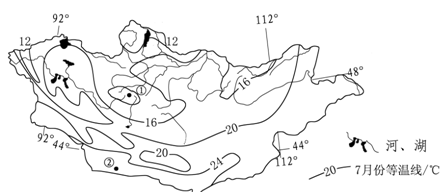图示意亚洲某内陆国水系分布和七月份气温分布情况。读图完成下列各题。

|
A.水汽主要来自北冰洋
B.年降水量自南向北递减
C.最大水系流域面积约占国土面积的一半以上
D.常年受西风带控制小题2:②地的自然带为
A.温带落叶阔叶林带
B.高山草甸带
C.温带荒漠带
D.亚寒带针叶林带
小题1:A
小题1:C
世界区域地理和等值线的综合分析。
小题1:根据图示的经纬度位置判断,该国为蒙古国,根据其地理位置和周边地形因素的影响,判断其受太平洋水汽影响少,而北部为西伯利亚平原,故来自北冰洋的水汽可能影响当地。故年降水量自北向南递减。
小题2:图示②地区位于亚洲大陆的内部,降水量少,故判断为温带荒漠带。
